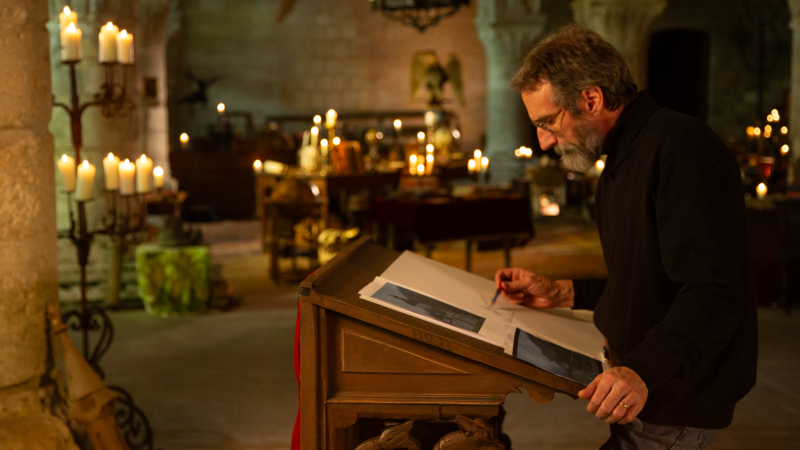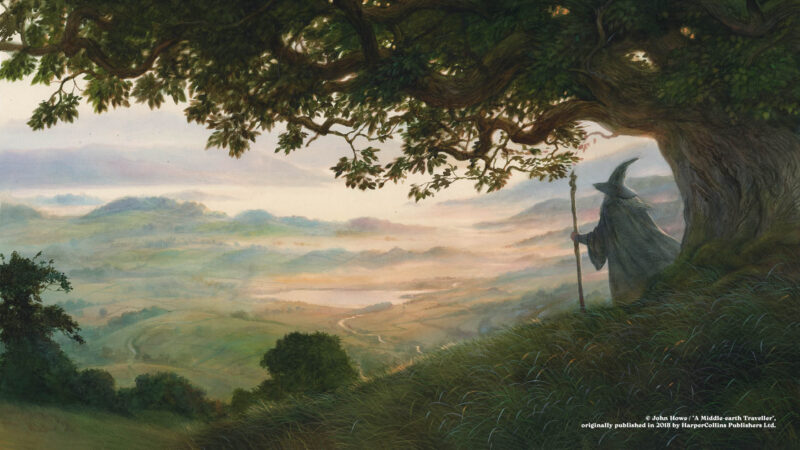THE ROOTS OF MEDIEVAL IMAGINARY

Though archetypical of medieval imaginary, epic tales, magic, and magical creatures have always been part of stories told by humans and can be found in all the mythologies of the world.
Among the fundamental texts of medieval imaginary is Beowulf, an epic poem composed around 750 AD. Inspired by an old Norse legend, Beowulf is considered a major work of Anglo-Saxon literature. The single surviving copy of the text was, however, partially damaged in a fire in the 18th century.
The poem tells the story of Beowulf, the young and brave nephew of the King of the Geats in Sweden, who goes to Denmark to challenge Grendel, the man-eating monster that nightly terrorises the residents of the mead-hall of Heorot. He confronts and subsequently kills first Grendel and later the monster’s mother in a heroic underwater fight. Returning to his family after his battles, Beowulf accedes to the throne and enjoys a glorious reign of more than fifty years.
However, one day a dragon threatens his people. Having become an old man and foreseeing that this will be his last battle, Beowulf does not hesitate to confront the creature. He ends up killing the beast but is mortally wounded, and succumbs to his wound after having contemplated the fabulous treasures guarded by the dragon. His body is burned in a ceremonial pyre and then buried in the middle of the treasure that the warriors decide to hide underground.
Beowulf exerted a remarkable influence on Tolkien’s fantastical imagination as well as his university life. The professor began working on a translation and gave conferences on the poem culminating in 1936 with the delivery of his essay “Beowulf: the Monsters and the Critics” in front of the British Academy.
Enthralled by the epic lyricism of the poem, Tolkien declared:
“That poem is close to painting!”
In addition to Beowulf, the medieval imaginary also drew on Scandinavian legends, such as the Icelandic Eddas, and other European epics such as The Völsunga Saga, The Song of the Nibelungs and The Kalevala.
These ancient, orally transmitted legends were also a source of inspiration for the first chivalry novels in the Middle Ages. For example, Erec and Enid by French writer and poet Chrétien de Troyes (written around 1160–1170) draws upon Celtic and Breton legends. De Troyes is considered the founder of Arthurian literature.
Scandinavian legends
At the intersection of mythology, poetry and epic tale, the Eddas are two volumes written in Old Norse, each of very different origin.
The Poetic Edda is a collection of old poems collected in the 13th century in an Icelandic manuscript known as the Codex Regius (‘The Book of the King’). The name refers to the book having been kept for centuries in the Royal Library of Denmark. It is believed that some of the poems date back to the 7th century.
To this day, the Codex is one of the most important sources of knowledge on Norse mythology.
The second Edda, called Prose Edda, was written between 1220 and 1240 by the Icelandic poet and historian Snorri Sturluson. A guardian of ancient traditions, Snorri wrote the book in order to share with the young Scandinavian poets the knowledge necessary to write. Skaldic poetry cannot be composed without perfect mastery of Old Norse and Germanic mythology, especially the symbols, metaphors and rituals. In his book, Snorri quoted several poems that had until then only existed in the oral tradition.
These poems turned out to be the very ones found in the Codex Regius. Magic prevails in these poems that recount the origin of the world and list all the gods inhabiting the city of Asgard under the aegis of Odin. In them, one meets Thor with his legendary hammer, the crafty Loki endowed with the power of metamorphosis, the sublime goddess Freya in her chariot drawn by two blue cats, giants coming out of the chaos, dwarves living in underground mines and elves, those wonderful, mysterious and luminous beings.
A Norse legend of Icelandic origin, The Völsunga Saga mainly draws upon a tale included in the Poetic Edda. This vast epic is particularly representative of the roots of medieval imaginary. It includes many major epic themes that have inspired authors, painters and composers throughout the ages.
The tale narrates, for example, the feat of the future King Sigmund, who becomes a hero by pulling a magic sword out of the mythical giant oak tree Barnstokkr. Odin had earlier planted the sword in the tree, and no one had been able to draw it out before.
Later on, Sigmund dies in battle at the hands of his enemies while his sword breaks into two pieces. As he lies dying, he entrusts his pregnant wife with the mission of keeping the pieces so that a new sword can later be forged for his son Sigurd.
Young Sigurd is brought up by Regin, a mysterious master blacksmith who one day reveals his origins to him: “My birth goes back to an epoch when Time didn’t exist. Giants and Dwarves possessed terrifying strength; the powers of the Magicians were so formidable that the Gods themselves feared crossing the lands of Midgard alone.“
Regin also tells Sigurd how the crafty god Loki stole the treasure and gold ring from the dwarf Andvari. This magic ring had the power of generating gold, so the treasure was forever growing.
To take revenge for the theft, Andvari casts a spell on the ring and the treasure, so that they will torment and destroy all those who have them in their possession.
The crafty Loki gave the cursed ring and treasure to the king of the dwarves, Hreidmar, to compensate for the death of his son Ótr, whom Loki had inadvertently killed some time before.
The curse soon worked on Fafnir, the brother of the dead Ótr. Obsessed with the ring, Fafnir murdered his father Hreidmar to take hold of it, then turned into a dragon to guard both the ring and the huge treasure.
Sigurd asks Regin to forge him a sword strong enough to kill Fafnir the dragon. Sigurd pays a visit to his mother who entrusts him with the two pieces of the broken magic sword that belonged to his father, and Regin melts them to forge a shiny, indestructible sword.
In the lair of Fafnir, Sigurd digs a hole in which he lies in wait for the dragon. When it comes along, he pierces its belly and all the way to its heart with his blade, liberating the ring and the treasure.
At that moment, the blacksmith Regin, now under the spell of the cursed ring, attacks Sigurd to take possession of the treasure. Sigurd, however, manages to dodge him and thrusting his sword, kills Regin.
In the course of the many adventures that follow, Sigurd sees a tower of stone surrounded by flames one night.
Riding his charger, he cuts the curtain of fire in two and discovers the coffin of a female warrior in the middle of the tower. The woman is Brunhilde, a former Valkyrie, banished by Odin for daring to defy him and condemned to wait for a brave hero to wake her. This is precisely what Sigurd does.
After many battles, adventures and romances, Sigurd enters the realm south of the Rhine ruled by the king of the Nibelung. Feted as a heroic dragonslayer, Sigurd is welcomed with every honour, and the king bestows his friendship on him.
However, the queen of Nibelung hatches a plot to make Sigurd marry her daughter, princess Gudrun. As a result Sigurd drinks a love potion that makes him fall in love with the princess. Their marriage is soon celebrated, and the magic gold ring is placed on Gudrun’s finger.
Gudrun and Brunhilde become ruthless rivals, for the latter has also reached the kingdom of the Nibelung, marrying Gunnar, the princess’ brother.
The ex-Valkyrie has Sigurd murdered, but wracked with guilt, takes her own life with his sword. The Valkyrie and the hero are incinerated side by side on a shared ceremonial pyre.
However, the curse persists. As time passes, Atli, the king of the Huns, who covets the treasure, massacres all the Nibelung, except Gunnar and his younger brother. The two have hidden the treasure at the back of a cave in the Rhine. After they refuse to reveal the location of the treasure, Atli kills the two brothers.
The king of the Huns is, however, murdered in the night in his palace by princess Gudrun as revenge for Atli having killed her brother, Gunnar. In the end, having become mad, Gudrun throws herself into the sea from the top of a cliff after looking at the cursed gold ring that shines on her finger for the last time.
The Völsunga Saga was a source of inspiration for many works, among them Ernest Reyer’s opera Sigurd, William Morris’ poem The story of Sigurd the Volsung and the fall of the Niblungs and Tolkien’s book of poetry The Legend of Sigurd and Gudrún, published in 2009.
The Völsunga Saga also influenced the most famous German epic poem of the Middle Ages, The Song of the Nibelung, written in the 13th century.
Sigurd, renamed Siegfried, forges a magic sword and, wearing a cape that makes him invisible and gives him strength beyond compare, succeeds in killing Fafnir the dragon and taking possession of the treasure of the Nibelung.
In Germanic legend, the “Nibelung” designate “those from the world down below”, the dwarves who extract vast resources from the mines situated under the mountains.
Siegfried the dragonslayer arrives at the court of Gunther, king of the Burgundians, as a hero and asks for the hand of his sister Kriemhild in marriage. The king accepts on the condition that Siegfried wins over the Brunhilda on his behalf. The hero succeeds in the mission the king entrusted him with, but Brunhilda, having become queen, falls in love with Siegfried.
The gold of the Nibelung has been cursed, and this leads the hero to his fall, due to the jealousy of king Gunther and his wife Brunhilda. The king’s vassal, Hagen, cunningly murders Siegfried and hides the treasure by throwing it in the Rhine. The saga continues with the intrusion of the king of the Huns, who marries Siegfried’s widow, herself driven by a terrible revenge. She kills her brother Gunther before decapitating Hagen, who refuses to reveal the location of the hidden treasure. She has all the Burgundians massacred before being executed by the king of the Huns to punish her merciless thirst for revenge.
Richard Wagner’s The Ring of the Nibelung, also named The Ring Cycle, originated in these Icelandic and Germanic legends.
The result of nearly 30 years of labour, this monumental cycle of four opera that Wagner started working on in 1848 and presented to the public in 1876, is made up of The Rhinegold, The Valkyrie, Siegfried and Twilight of the Gods and lasts fourteen hours.
In The Rhinegold, Alberich, a dwarf from the Nibelung, steals the priceless treasure of the Daughters of the Rhine. With their gold, he forges a ring that subjects everyone to his will. However, the god Wotan (Odin) and later the dragon Fafnir end up taking possession of the accursed treasure. The gods, the Valkyries, the warriors, violence, heroism, treason, the calming nature, the love between Siegfried and Brunhilda – all these elements combine to form the next three operas, ending with Twilight of the Gods, in which the Daughters of the Rhine recover the ring.
The epic of Kalevala resonates like a song steeped in ancient legends and traditions to transmit the soul of Finland.
Published in its definitive form in 1849, The Kalevala consists of 50 songs. It is the result of a monumental expedition led by Elias Lönnrot, a young country doctor and linguist. Although Finland had been under Swedish rule for more than six centuries, the young patriot took an interest in Finnish, his mother tongue.
Becoming an explorer for a while, Lönnrot decided to go and collect Finnish folk tales as far as the most remote lands of the country, like White Sea Karelia. These ancient poems were chanted by the bards who sometimes accompanied themselves on the kantele, a traditional string instrument.
Lönnrot brought together all the songs, composing a fabulous literary work that became a unifying national epic for Finland: The Kalevala.
The Kalevala tells the creation of the world from an egg of a bird laid on the lap of the goddess Ilmatar, the “Woman-Air”, and represents an impassioned hymn to nature and the beauty of the world. It also describes rural daily life, its traditions, its marriages and even beer brewing.
The book also narrates the legendary fight against Pohjola, the land of evil ruled by the witch Louhi, who covets the legendary Sampo, a mythical object that brings its holder happiness and prosperity.
The main character of the story, the old bard Väinämöinen, plans to steal the Sampo. Mastering the art of chanting, he confers on words the power to create objects, such as the boat on which he navigates between the Finnish islands.
Another tale included in the book is the tragic story of Kullervo, an orphan abused in his childhood but gifted with magic powers. Thirsty for revenge, he becomes a ruthless and violent man whose life ends in a dreadful manner.
The dramaturgy of the tale of Kullervo was so poignant that it deeply influenced Tolkien who decided, at the age of 22, to write The Story of Kullervo, his darkest tale by far. Although unfinished, the book still gave him the basis for the sad story of Turin Turambar in The Silmarillion.
Tolkien later told: “The germ of my attempt to write legends of my own to fit my private languages was the tragic tale of the hapless Kullervo in the Finnish Kalevala. It remains a major matter in the legends of the First Age (which I hope to publish as The Silmarillion).” It was indeed from The Kalevala, written in Finnish, that Tolkien drew part of his sources for the creation of Quenya, one of the main elf languages.
Epilogue: Beren ja Lúthien
Tolkien retired in 1959 but kept his room at Oxford University, where he spent many years making alterations to The Lord of the Rings and reworking The Silmarillion, a mythological work to which he had devoted a large part of his life.
His wife Edith Tolkien died in 1971. Heartbroken, the author passed away two years later. On their graves is written “Beren and Lúthien”, a moving epitaph straight out of the writer’s imagination. In The Silmarillion, Lúthien, the princess of the Sindar people, was the first elf to marry a mortal, Beren.
The son Christopher Tolkien edited a vast amount of his father’s previously unpublished writings, which were published as The Silmarillion, The Book of Lost Tales, the 12-volume series The History of Middle-earth, Beowulf and the Critics, The Legend of Sigurd and Gudrún, The Story of Kullervo and The Fall of Arthur.
In his review of the 2021 publication, The Nature of Middle-earth, the historian Bradley J. Birzer declared:
“Tolkien was the 20th century’s greatest mythmaker, and his mythology will — if there is justice in the world — rank someday with that of Homer, Virgil, and Dante. Just as Homer gave us profound insights into the Greek world, Virgil into the Roman world, and Dante into the medieval world, Tolkien gave us great insights into the modern world. Everything Tolkien wrote matters.”

